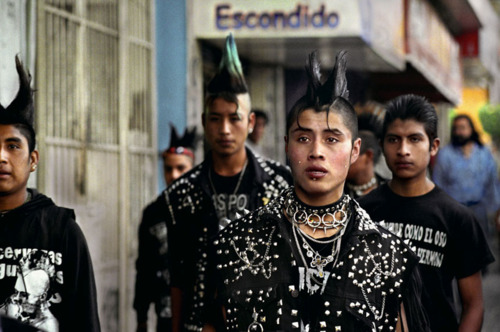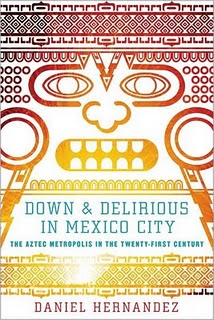
Escondido, 2005, from the Mazahuacholoskatopunk series. Photo by: Federico Gama
Down & Delirious in Mexico City: The Aztec Metropolis in the Twenty-First Century
Daniel Hernandez
Publisher: Scribner
Published date: February 8, 2011
By guest contributor Susy Chavez of mexiroccan.blogspot.com
There is a legend that runs through artist circles in Mexico about the surrealist French photographer Henri Cartier-Bresson’s first visit to that country. They say Cartier-Bresson was so moved and overwhelmed with visual stimulation that he declared all one had to do to find a surrealist image while in Mexico was to point one’s camera and simply shoot. Apparently, Cartier-Bresson found the surrealist promised land in le Mexique.
I often times find myself imagining Mr. Cartier-Bresson wondering the streets of Mexico camera and western sensibilities in hand, like some sort of belated colonialist explorer encountering the totem-like mishmash of the ancient, colonial and the modern that makes up Mexico. My own voyeuristic fascination with Mexico, like all the best voyeuristic endeavors in life, is deeply personal. I am, to put it mildly, passionately in love with its fluid pump-up-the-color-volume folklorico-piñata-dance chaos. Fortunately, this love abounds and Daniel Hernandez’s new book, a quasi telenovela meets Boogie Nights love letter to the 20 plus million metropolis that is Mexico City, is a worthwhile testament.
To take Hernandez’s book as simply a non-fiction travel book or as the cool kids are calling it these days, creative non-fiction travel book, would be a mistake. Hernandez’s book is fascinating precisely because he is NOT: 1) trying to find himself by teaching English in another country 2) throwing himself into hard labor in a remote indigenous village 3) has no philanthropic endeavors 4) and NO broken heart he needs to mend through ancient indigenous practices. Hernandez is on a mission to find himself, a San Diego native, Angeleno transplant via Tijuana, Mexico whose parents warn him early on that in el DF, he’ll get his socks stolen while he’s got his shoes on. Instead of making him run up towards Canada, Hernandez, a self-described “dark-skinned†pocho mexi-gringo, decides to move to el monstruo. It is in el monstruo that Hernandez leads us through a series of hoyos funkys, underground tunnels that weave through the city coming up momentarily from time to time for brief snap-shots of a series of urban subcultures that include but are not limited to fashionista fairies, nezayorkinos, banda, grafiteros, emos and fresas.

One of, I believe, nine children raised by immigrant parents in Southern California, by the end of the book you get a sense that Hernandez is some sort of desert chameleon one minute drinking a with a friend in a run-down prostitute laden side of town and the next schmoozing with the crème-de-la-crème Mexican up-and-coming fashion, artist, writing crowd. I suppose a warning against whiplash is in order. Nevertheless, it is through these encounters that Hernandez not only lays out the mega-city for us with all of its divine contradictions, but it is precisely through these urban-life snippets that he refreshingly peels back and exposes his own identity based struggles. Knowing exactly from where he was coming, I found myself wanting to reach through the pages to shake his hand on several occasions. There are particularities to being a fill-in-the-blank –American and going back to the country of “origin†that I believe might transcend beyond one particular experience or culture, Hernandez’s book would fit that category. The prodigal son that leaves the land of opportunity for the land our parents left behind. This is not Cartier-Bresson getting off a plane baptizing Mexico as the surrealist-promised land.
The book is a quick read at that, one that I intentionally extended and savored piece by piece until despite my every effort it’s pages ran out. At the end of the journey through one of the largest urban jungles in the world, it is obvious that although Hernandez is gifted with those chameleon-like tendencies I previously mentioned, it is the magic of the city itself that allows Hernandez and the millions of transplants that keep pumping into it, to transform themselves day in and day out.
